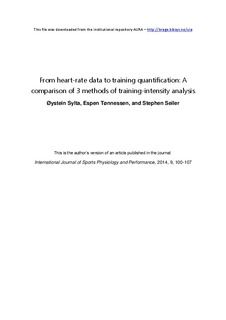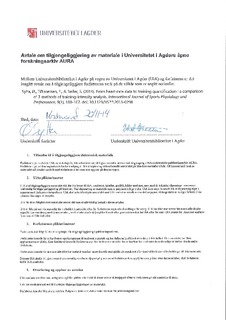| dc.contributor.author | Sylta, Øystein | |
| dc.contributor.author | Tønnessen, Espen | |
| dc.contributor.author | Seiler, Stephen | |
| dc.date.accessioned | 2014-12-10T07:03:01Z | |
| dc.date.available | 2014-12-10T07:03:01Z | |
| dc.date.issued | 2014 | |
| dc.identifier.citation | Sylta, Ø., TØnnessen, E., & Seiler, S. (2014). From heart-rate data to training quantification: A comparison of 3 methods of training-intensity analysis. International Journal of Sports Physiology and Performance, 9(1), 100-107. doi: 10.1123/IJSPP.2013-0298 | nb_NO |
| dc.identifier.issn | 1555-0265 | |
| dc.identifier.uri | http://hdl.handle.net/11250/226883 | |
| dc.description | Author's version of an article in the journal: International Journal of Sports Physiology and Performance. Also available from the publisher at: http://dx.doi.org/10.1123/IJSPP.2013-0298 | nb_NO |
| dc.description.abstract | Purpose: We directly compared three frequently used methods of heart-rate based training intensity distribution (TID) quantification in a large sample of training sessions performed by elite endurance athletes. Methods: Twenty-nine elite XC skiers (16 male, 13 female, 25 ± 4 yr, 70 ± 11 kg, 76 ± 7 mL . min-1 . kg-1 VO2max) conducted 570 training sessions during a ~14 d altitude training camp. Three analysis methods were used; Time in Zone (TIZ), Session-Goal (SG) and a hybrid Session-Goal/Time in Zone (SG/TIZ) approach. The proportion of training in zone 1, zone 2 and zone 3 was quantified using total training time or frequency of sessions, and simple conversion factors across different methods were calculated. Results: Comparing the TIZ and SG/TIZ methods, 96.1 and 95.5 % respectively of total training time was spent in zone 1 (P < .001), with 2.9/3.6 and 1.1/0.8 % in zones 2/3 (P < .001). Using SG, this corresponded to 86.6 % zone 1 and 11.1/2.4 % zone 2/3 sessions. Estimated conversion factors from TIZ or SG/TIZ to SG and vice versa, were 0.9/1.1 respectively in the low intensity training (LIT) range (zone 1), and 3.0/0.33 in the high intensity training (HIT) range (zone 2 & 3). Conclusions: This study provides a direct comparison and practical conversion factors across studies employing different methods of TID quantification associated with the most common HR based analysis methods. | nb_NO |
| dc.language.iso | eng | nb_NO |
| dc.publisher | Human Kinetics | nb_NO |
| dc.subject | XC skiers | nb_NO |
| dc.subject | endurance training | nb_NO |
| dc.subject | intensity distribution | nb_NO |
| dc.subject | time in zone | nb_NO |
| dc.subject | session goal | nb_NO |
| dc.title | From heart-rate data to training quantification: A comparison of 3 methods of training-intensity analysis | nb_NO |
| dc.type | Journal article | nb_NO |
| dc.type | Peer reviewed | nb_NO |
| dc.subject.nsi | VDP::Medical disciplines: 700::Sports medicine: 850::Exercise techniques: 851 | nb_NO |
| dc.source.pagenumber | 100-107 | nb_NO |
| dc.source.volume | 9 | nb_NO |
| dc.source.journal | International Journal of Sports Physiology and Performance | nb_NO |
| dc.identifier.doi | 10.1123/IJSPP.2013-0298 | |

